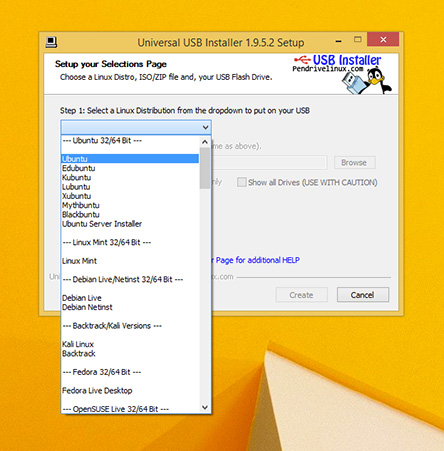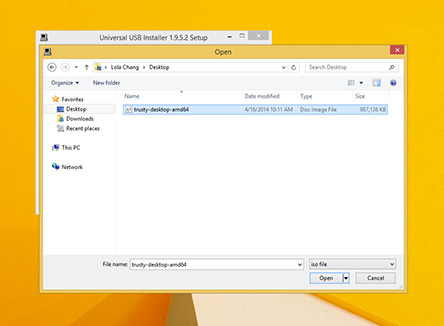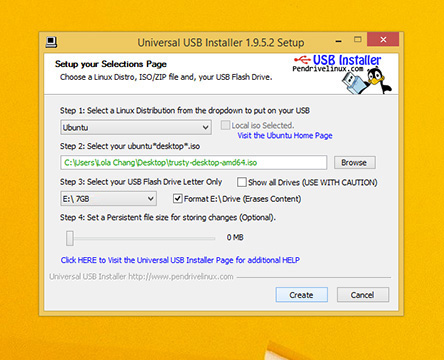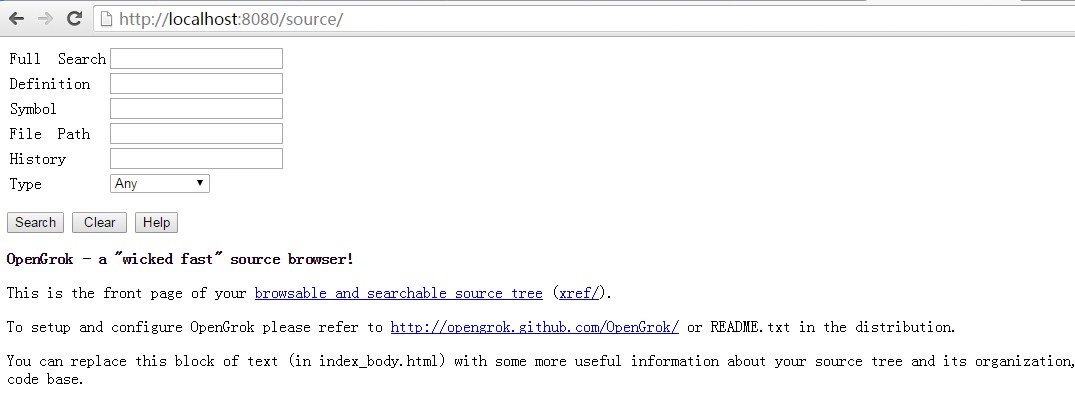Ubuntu 15.10 中,已经可以使用Ubuntu Make简化Android开发环境配置了,具体方法如下:
1.安装Ubuntu Make
2.配置Android开发环境
然后根据提示,一步一步操作就可以了。
一会之后,就会发现Android Studio已经安装成功了。
就是这么简单!
Ubuntu(友邦拓,网友也喜欢称之为“乌班图”)是一个以桌面应用为主的Linux操作系统,其名称来自非洲南部祖鲁语或豪萨语的“ubuntu”一词,意思是“人性”、“我的存在是因为大家的存在”,是非洲传统的一种价值观,类似华人社会的“仁爱”思想.
Ubuntu 15.10 中,已经可以使用Ubuntu Make简化Android开发环境配置了,具体方法如下:
1.安装Ubuntu Make
2.配置Android开发环境
然后根据提示,一步一步操作就可以了。
一会之后,就会发现Android Studio已经安装成功了。
就是这么简单!
要从U盘运行Ubuntu,需要插入一个至少2G空余空间的U盘。使用USB安装器是将Ubuntu安装到U盘最简单的方式,它由 pendrivelinux.com 提供。下载Pen Drive Linux’s USB安装器后,安装并运行。也可本站下载。
从下拉选项中选择Ubuntu桌面版本,或者自行用BT、迅雷等软件下载Ubuntu ISO文件。

点击“浏览”然后打开已下载的ISO文件。
选择一个USB驱动器并点击“创建”,注意,U盘里的数据请备份,“创建”过程会格式化U盘。

Ubuntu系统本身附带一个小程序Startup Disk Creator,直接制作可启动U盘Ubuntu系统。本站下载
Ubuntu 环境,当apache2重启提示:
解决的问题是:
打开default文件后,在default文件顶端(第一行)加入:
重启Apache2就不会提示上述错误了。
参考链接
Ubuntu Apache2重启提示could not reliably determine the server’e fully…问题解决
OpenGrok是一个快速,便于使用的源码搜索引擎与对照引擎,它能够帮助我们快速的搜索、定位、对照代码树。接下来就具体讲解Ubuntu 12.04 LTS环境下OpenGrok的安装及使用。
1.参照 UBUNTU 13.10 APACHE 2.2 通过 AJP 整合 TOMCAT 7 中讲述的方法,进行Tomcat,Apache2的配置安装。
2.安装ctags用于对C\C++代码的支持
3.下载并安装OpenGrok
可以到"http://opengrok.github.io/OpenGrok/"手工下载文件,然后上传到服务器,也可以直接用wget命令来下载,一般选择安装在"/opt"目录下面。
解压缩文件到当前目录"/opt"
创建一个软链接,方便后续的修改
拷贝"/opt/opengrok/lib/source.war"到Tomcat7的工程目录"/var/lib/tomcat7/webapps/"
访问"http://localhost:8080/source/"确认OpenGrok是否已经安装成功,如果安装成功,出现下面的界面:
4.出于安全原因,禁止外网访问Tomcat的8080端口
只允许Tomcat在本地的8080端口监听即可,修改
添加 address="127.0.0.1"
重启Tomcat7
5.配置Apache2对Tomcat通过AJP进行反向代理
Apache2的配置文件“ /etc/apache2/sites-available/default”中,增加如下配置:
Tomcat7的配置文件/var/lib/tomcat7/conf/server.xml中增加如下配置<Context path="/AndroidXRef" docBase="source/"/>,解决跳转404问题。ProxyPass后面必须携带“/”,否则就会出现404问题。
6.配置OpenGrok对源代码进行解析
设置要建立索引的源代码目录的位置,以存储在"/data/OpenGrok/Android_4.2"上的Android代码为例子:
注意:
由于我们使用了Apache2的反向代理才需要设置 OPENGROK_WEBAPP_CONTEXT,如果没有设置反向代理,请不要设置OPENGROK_WEBAPP_CONTEXT。
在使用反向代理的时候如果不设置OPENGROK_WEBAPP_CONTEXT会导致在点击具体的变量定义的时候,出现404.
不使用反向代理的时候请只设置OPENGROK_INSTANCE_BASE
创建源代码索引
执行时间在40分钟左右,执行完成。生成的索引文件在源代码的"data"目录下面,重建索引的时候需要执行如下操作,才能再次建立索引
注意,请务必删除源代码中的"prebuilts"目录,这个目录下面存储的是一系列的编译工具,在浏览代码的时候,完全用不上,但是占据的磁盘空间确是巨大的。
注意,如果服务器上面的内存比较有限,请使用如下命令进行内存限制,否则建立索引的时候,会触发内存不足的情况:
修改OpenGrok配置文件
修改其中的
为具体的工程目录"/data/OpenGrok/Android_4.2",修改后的配置如下:
刷新浏览器,可以看到Android_4.2的源码可以搜索出来了。
使用cp -r -f 强制覆盖拷贝命令时,每一个文件都需要认为的键入“Y”进行确认,甚是烦扰,难道要我点击一万下不成?
cp命令被设置了别名
alias cp='cp -i'
所以在每次执行cp命令是都会按照这个设置进行人为的确认(-i参数的含义)。
一.使用unalias cp命令 解除对cp的别名(仅本次终端连接会话临时取消),我们先输入alias命令,查看系统内部已经设置的别名:
输入unalias cp命令,取消cp命令的别名.
二.直接输入\cp命令,作用也是取消cp的别名
三.使用管道的方式,自动输入yes
Windows/Ubuntu双系统用户会发现在Ubuntu里面的时间正常的情况下Windows的系统时间被改到8小时前。
原来Linux操作系统是以CMOS时间做为格林威治标准时间,再根据系统设置的时区来确定目前系统时间。但是Windows会直接修改CMOS时间。而中国的时区是+8区,所以才会造成时间被调整了-8个小时。
所以您可以让Windows去使用时区或者让Ubuntu使用本地时间。
修改Windows使用时区的方法是在注册表:
下面增加一个名为RealTimeIsUniversal的REG_DWORD键,并赋值为1。
对于Ubuntu 16.04以下版本, 使用本地时间的方法是:
把里面的 UTC=yes 改为 UTC=no
对于Ubuntu 16.04以及之后的版本(如:Ubuntu 18.04),使用如下命令:
SPDY是Google开发的基于传输控制协议(TCP)的应用层协议,该协议规定在一个SPDY连接内可以有无限个并行请求,服务器可以主动向客户端发起通信向客户端推送数据,通过请求优化、预加载、压缩HTTP 来达到加速的目的。
对用记而言,SPDY是基于SSL加密,它可以让网络访问更安全,用户隐私更加得到保护。对站长而言,SPDY在降低连接数目的同时,还使服务器上每个客户端占用的资源减少,从释放出更多内存和CPU ,让网站的浏览速度提升不少。
SPDY协议已经被Chrome、Firefox、Opera、IE 11以上支持,用户在访问使用SPDY协议加载的网站几乎感觉不到与普通的Https页面访问有何不同,而SPDY带来的页面加载速度提升和服务器性能优化确是有十分重要意义的。
具体的操作步骤如下:
参考 UBUNTU 12.04 下 APACHE 2.2.22 开启 HTTPS
官网:https://developers.google.com/speed/spdy/mod_spdy/
由于众所周知的原因,本站提供下载(2015-11-6版本)
mod_spdy 64-bit .deb (Debian/Ubuntu)
mod_spdy 32-bit .deb (Debian/Ubuntu)
目前验证貌似没有起作用啊!目前最新的chrome已经没办法进行验证了,主要是由于HTTP/2已经发布,Google放弃了spdy,转而支持HTTP/2,还是静待新版本的HTTP/2吧。
Linux Mint + Apache2.2搭建SSL/HTTPS/SPDY服务器
https://developers.google.com/speed/spdy/mod_spdy/
在使用WP-Statistics统计插件的时候,提示GeoIP需要 php-curl扩展。搜索了一下,安装方式如下:
安装完成后,需要重启Apache2
在安装Ubuntu 15.04的时候,由于机器使用的是SSD硬盘,因此在建立HOME分区的时候选择了使用Btrfs格式作为分区格式。一直都是使用正常,直到今天,在向HOME分区拷贝一个16GB的文件的时候提示 “拼接文件出错:设备上没有空间” (英文系统可能会提示 “No space left on device”)。
使用"df"命令查询分区,发现所有分区都是足够的。如下图所示,空间足够使用,尤其是HOME分区,足足有40GB的空间。
维基百科搜索“btrfs”,简介中标明,最大文件尺寸 16 EiB,显然,16GB的文件,是不会超过这个限制的。
同样是维基百科,btrfs条目,标明 最大文件数量 2^64,显然,120GB的一个硬盘,即使是全部是一个字节的小文件,也达不到这个数字的。
使用"df -i"命令查询Inode信息,发现好奇怪的现象,home所在的分区信息中Inode信息,不管是已经你使用的,还是可以使用的,还是总数,都是 0. 为什么呢?
 后来才知道,btrfs格式是不能使用df命令的,btrfs有自己的单独的命令查询.
后来才知道,btrfs格式是不能使用df命令的,btrfs有自己的单独的命令查询.
仔细观察一下输出结果,好奇怪,使用df 命令,我们查询到分区的大小在90GB左右,但是这里显示的文件的大小仅仅是43GB,而且已经使用了42.50GB,按照这个显示,自然是空间不足了,那么,我们的空间去了哪里?
这个问题的产生,本质上是btrfs设计导致的,原因归咎于btrfs所采用的COW技术,这项技术需要一个比较大的保留存储空间,但是当空间不足的时候,本应减少保留空间,而显然,默认情况下,没有正确处理这种情况。这个问题在3.18版本之后得到比较好的解决。
对于 btrfs 3.18之前的版本来说,执行如下命令即可.
从3.18版本开始,这个命令是当空间不足出现的时候,默认执行的,很遗憾,15.04的btrfs版本号是3.17.
显示btfs文件系统信息
btrfs磁盘文件检查(需要重启进入修复模式中执行)
Btrfs Problem_FAQ
Ubuntu thinks btrfs disk is full but its not